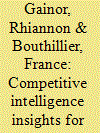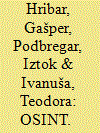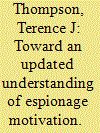|
|
|
Sort Order |
|
|
|
Items / Page
|
|
|
|
|
|
|
| Srl | Item |
| 1 |
ID:
132443


|
|
|
|
|
| Publication |
2014.
|
| Summary/Abstract |
For competitive and business intelligence, as for covert or military intelligence, the term "intelligence" connotes a combination of raw data, technology, and analysis resulting in intelligence deliverables such as reports and profiles. For all intelligence fields, the primary purpose of intelligence is to inform decisionmaking, with the intent of increasing the likelihood of the most optimal outcomes for the organization. 1 Competitive intelligence in the business sector is sometimes called by other labels, such as business or market intelligence. 2 It involves surveying and monitoring the competitive environment and developing intelligence to inform decisionmaking.
|
|
|
|
|
|
|
|
|
|
|
|
|
|
|
|
| 2 |
ID:
132431


|
|
|
|
|
| Publication |
2014.
|
| Summary/Abstract |
Open Source Intelligence (OSINT) is generally seen in positive terms, particularly as a method of conventional intelligence collection that does not violate human rights. Of all the data collection methods, OSINT is, arguably, the only fully legal method. It can be conducted anytime, anywhere, and with any (legal) tools/software, as long as it does not violate human rights. In principle, however, OSINT does not and should not violate human rights, therefore such tools are all, again arguably, legal. Thus, its legality makes OSINT globally available, including to markets around the world. The free market offers various legal tools that facilitate the analytical procedures of data acquisition and analysis, and which no longer represent a major technical and logistical obstacle. Hypothetically, OSINT can be carried out by anyone with such specific tools and knowledge. These tools can be obtained by anyone free of charge or by paying for the licensed program, while the knowledge necessary to conduct OSINT is relatively easily acquired. Even though the tools and knowledge are freely accessible, the major difference between basic and excellent OSINT "operations" lies in the analytical process. Only experts with good analytical skills and knowledge manage to provide the right information at the right time to their customers/policymakers. OSINT is also a formal tool and means of analytical support in the work of intelligence services. Intelligence service analysts are capable of the advanced use of OSINT-they are familiar with specialized sources of specific data, advanced techniques of acquiring data, and the analytical steps needed for successful processing, exploitation, and analysis of massive amounts of data. The exploitation of special sources and the use of advanced techniques make OSINT questionable when seen through the prism of legality. The exploitation is at times semi-legal or even, arguably, illegal. The use of "special" techniques in OSINT can therefore lie on the edge between the legal and the illegal. These actions are sometimes clearly illegal, of course, and therefore forbidden by the criminal law; such practice by the intelligence services is not sanctioned. This raises the following questions: Could the intelligence services using OSINT in a legal manner to serve their specific individual interests interfere in another country on the ground of this same legality? Without this hypothetical "grey zone" would they be acting illegally and so become subject to counterintelligence observation?
|
|
|
|
|
|
|
|
|
|
|
|
|
|
|
|
| 3 |
ID:
130228


|
|
|
|
|
| Publication |
2014.
|
| Summary/Abstract |
The case of Edward Snowden, who in May 2013 revealed a huge number of National Security Agency codes, has again raised the question of motivation in espionage and disclosure of documents.
Espionage is a crime with complex, multi-faceted motivational factors that do not lend themselves to easy explanation. Most cases present a singular mosaic of intersecting psychosocial forces which culminate in a decision to engage in the crime. Espionage is committed by individuals from the lower middle to upper middle classes; unlike street crime, it is rarely, if ever, committed by the poor. What drives people of middle class privilege to choose to commit such a heinous crime?
The current model, postulated by numerous scholars and simplified here, holds that espionage occurs at the collision of an opportunity, a perceived life crisis, and a moral failing, which is then actuated by a trigger. 1 The spy must have an opportunity, which usually translates into access to information or a person. Access to information is typically gained through the holding of a security clearance. Such a trusted insider has minimally restrained access to classified information, and that access is usually defined by position. A senior scientist working on satellite systems obviously has significant access to classified satellite data but may have almost no access to human intelligence (HUMINT)-and vice versa. Conversely, and perhaps surprisingly, according to one study, 25 percent of known spies since World War II have held no security clearance. 2 These spies usually acted in concert with another individual (often a spouse or lover), or simply knew someone who did have access. This was the case in the Boyce-Lee case in California wherein Christopher Boyce held a security clearance and Dalton Lee did not. 3 Access, however derived, represents the most common opportunity to commit espionage.
|
|
|
|
|
|
|
|
|
|
|
|
|
|
|
|
|
|
|
|
|